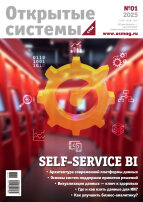_300x.jpg)
COVER FEATURES
QUANTUM TECHNOLOGIES
Quantum Computing: from Science to Applications
Based on phenomena such as quantum superposition and entanglement, quantum computing devices could be more efficient at solving certain complex tasks than traditional ones.
Alexei Fiodorov (akf@rqc.ru), Quantum IT Group Leader, Russian Quantum Center, Skolkovo (Moscow).
Practical Annealing-Based Quantum Computing
Quantum computers have the potential to facilitate extraordinary breakthroughs that will transform modern society: lives could be saved by more efficient and effective drug designs, discovery in materials science could be revolutionized by simulations of quantum processes, and Internet encryption as we know it could be broken and then replaced by much more secure methods. Or maybe quantum computers will never do anything useful.
Catherine C. McGeoch (cmcgeoch@dwavesys.com) Benchmarking Team principal scientist, Richard Harris (rharris@dwavesys.com), principal scientist, Steven P. Reinhardt, group lead, Paul I. Bunyk (pbunyk@dwavesys.com), chief processor architect, Design and Layout Team lead, D-Wave.
A Hybrid Approach for Solving Optimization Problems on Small Quantum Computers
In recent years, quantum devices have become available that enable researchers — for the first time — to use real quantum hardware to solve problems. However, the number and quality of qubits (the basic unit of quantum information) for universal quantum computers are expected to remain limited, making it difficult to use these machines for practical applications. Concerns about qubit connectivity, high noise levels, the effort required to correct errors, and the scalability of quantum hardware have also limited researchers’ ability to deliver the speed that future quantum computing promises. A hybrid quantum and classical approach may be the answer to tackling this problem with existing quantum hardware.
Ruslan Shaydulin (rshaydu@g.clemson.edu), Ph.D. student, Clemson University; Hayato Ushijima-Mwesigwa (hushiji@g.clemson.edu), research scientist, Fujitsu Laboratories; Christian F. A. Negre (cnegre@lanl.gov), Susan M. Mniszewski (smm@lanl.gov), staff scientists, Los Alamos National Laboratory; Ilya Safro (isafro@ g.clemson.edu), associate professor, Clemson University School of Health Research; Yuri Alexeev (yuri@anl.gov), principal project specialist, Argonne National Laboratory.
PLATFORMS
TrueNorth: Accelerating From Zero to 64 Million Neurons in 10 Years
IBM’s brain-inspired processor is a massively parallel neural network inference engine containing 1 million spiking neurons and 256 million low-precision synapses. Now, after a decade of fundamental research spanning neuroscience, architecture, chips, systems, software, and algorithms, IBM has delivered the largest neurosynaptic computer ever built.
Dharmendra S. Modha (dmodha@us.ibm.com), fellow, IBM.
INTEGRATION
Enterprise Systems Integration: RPA
Optimizing internal corporate data storage, movement, and processing is impossible without integrating IT systems, with traditional ways of integration sometimes being not applicable in modern settings. Robotic process automation technologies have enabled a novel approach to integrating with closed and legacy systems, as well as the ones that lack APIs.
Ivan Seredkin (i.seredkin@hyperup.ru), business development director, HyperUp (Moscow).
DIGITAL TRANSFORMATION
Service Desk of a Digital Enterprise
Service Desk solutions could become a driving force of digital transformation, but in order to preserve control over dynamic IT infrastructure, they should be able to integrate with new smart management, monitoring, and robotic process automation technologies.
Natalia Kalimanova (Kalimanova.Natalia@smartservicedesk.ru), Sergei Lyamukov (Lyamukov.Sergey@smartservicedesk.ru), staff members, SmartServiceDesk (Moscow).
SOFTWARE ENGINEERING
Scale Your Team Horizontally
Not long ago, when your company became successful, you bought a bigger computer to run your software. We called this scaling vertically. Today, that is less common, in part because we have gotten quite good at scaling horizontally so when your company becomes successful, it buys more of the same-sized computers.
In this article, a related idea is discussed: scaling our teams horizontally instead of vertically.
George Fairbanks (gf@georgefairbanks.com), software engineer, Google.
INTERNET
Dynamic Semantic Data Aggregation
Currently existing tools for on-the-fly inclusion of real-time data from various online resources into web pages require programming skills. Unlike such solutions, the StructScraper tool that uses HTML microdata enables to create, without coding, web pages containing semantic information and metadata from external websites as of the access time.
Evgeny Kitayev (kitaev@keldysh.ru), Rimma Skorniakova (RimmaSkorn@gmail.com), fellows, M. V. Keldysh Institute of Applied Mathematics (Moscow).
OS ACADEMY
National Healthcare Data Management Challenges and Outlook
Boris Zingerman, the head of National Healthcare Knowledge Base Association that brings together medical AI developers and users, talks about healthcare data management approaches that pay attention to the needs of country residents, healthcare service providers, and government.
Irina Sheyan (rrisha@osp.ru), reviewer, Open Systems.DBMS Journal (Moscow).
LIBRARY
New Computing Types 360: Cognitive, Quantum, Transformational, Osmotic
The May, June, July, and August issues of Computer Magazine (IEEE Computer Society, Vol.52, No. 5–8, 2019) cover computing systems, quantum and transformational computing, communications, as well as the “cloud osmosis”.
Andrei Nikolayenko (ANikolaenko@Ibs.ru), architect, IBS (Moscow).
